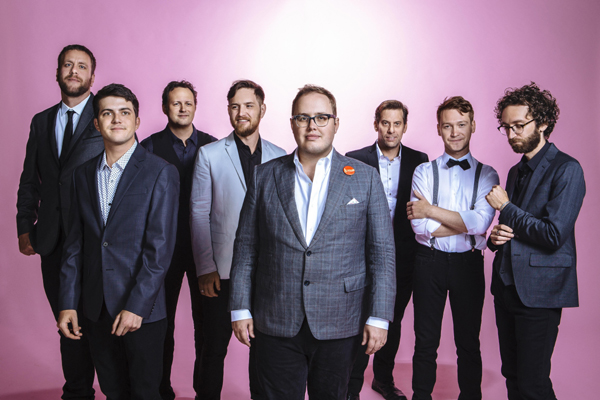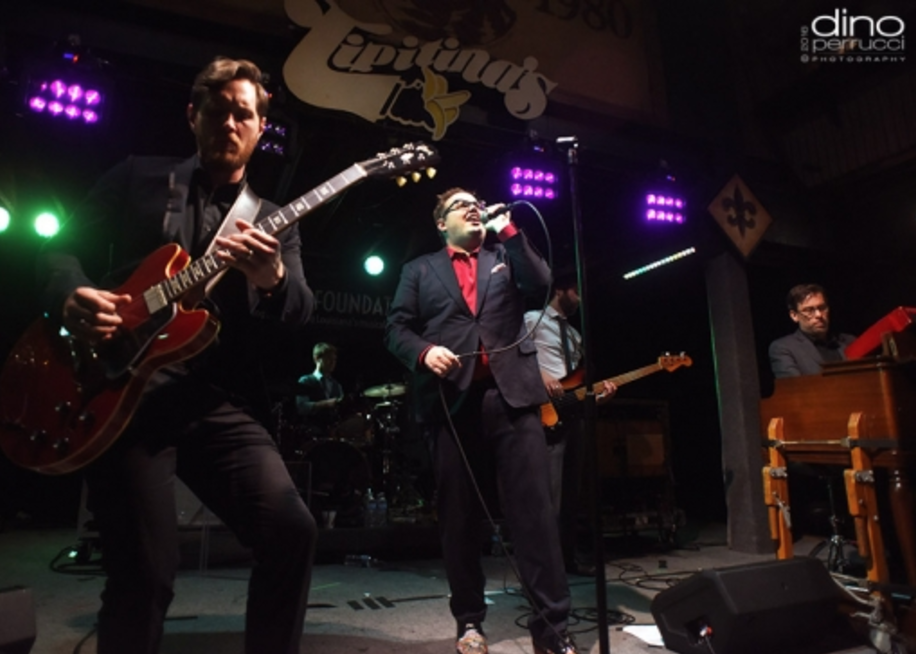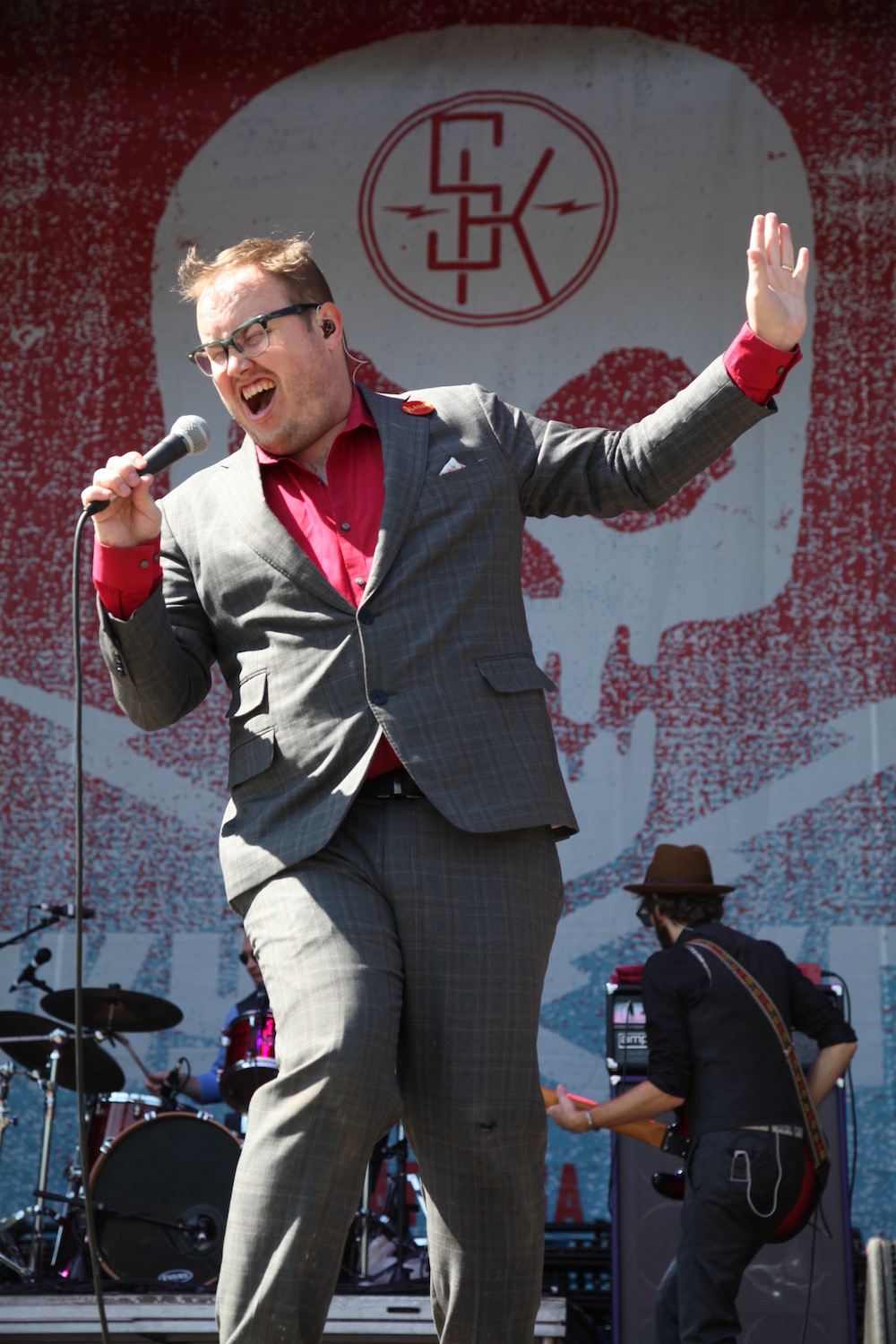St. Paul & the Broken Bones: The Charge of the Light Brigade

“It’s only gonna get weirder,” St. Paul & The Broken Bones frontman Paul Janeway says of the music that he expects will flow from his group over the years and albums to come.
The band’s second record, Sea of Noise, is already a step in that direction.
The ethereal opening piece, “Crumbling Light Posts, Pt. 1,” announces itself in an altogether different way from the brass-infused slice of soul that began the group’s debut, Half the City. Janeway and a guest choir intone, “We’re just crumbling light, crumbling light in a sea of noise,” for the first of three such sequences on the album. “Crumbling Light Posts” also appears in the middle and at the end, serving as atmospheric tent poles.
These lyrics are drawn from British Prime Minister Winston Churchill’s book, The Grand Alliance: The Second World War, in which Churchill describes ailing American politician Harry Hopkins, an advisor to President Franklin Delano Roosevelt, as “a soul that flamed out of a frail and failing body. He was a crumbling lighthouse from which there shone the beams that led great fleets to the harbor.”
This quote was the starting point for Janeway, who modified the imagery to reflect some of the challenges of the modern age, which is a recurring theme throughout the album. “In my mind, it’s not a total concept record,” he explains, “but there are some common themes and some conceptual, binding ideas. As we experience life in the era of the laptop, you can feel like you’re eventually going to get sucked in. You’re going to fall and become noise.”
Janeway’s longtime collaborator and St. Paul & The Broken Bones co-founder/ bassist Jesse Phillips adds, “The idea is to represent the individual in the modern world full of distraction and influence and information manipulation, where you’re trying to maintain humanity and identity and do what’s right, even though you’re exposed to everything that surrounds you via the cable news and internet news cycles.”
These sentiments are in stark contrast with the musings on love and heartache that predominated on the group’s first album. Indeed, this is not your mother’s St. Paul & The Broken Bones. Except that it is. And it’s your great aunt’s and your little cousin’s, too—a fact that has not gone unnoticed by the band, which has demonstrated the unique ability to span generations in its appeal.
“It’s bizarre: We’ve had grandmothers and granddaughters come out to our shows,” Janeway reflects. “We played a festival outside of D.C., called Sweetlife. It was Kendrick Lamar, The Weeknd, and all this other stuff, including us. We had a great show, and, I’ll never forget, on the screen it said, ‘For parent pick up, go to this aisle.’ It was an odd feeling for me but a really good one. It’s crazy, but I think that writing real songs and having real music is never going to go out of fashion. And when you see someone giving everything they’ve got, you can feel it. That’s what we aspire to do.”
Phillips concurs: “The joke in our band is that what we lack in finesse, we make up for with effort. In that respect, there’s a modern energy and edge and immediacy to the music that younger folks can latch on to, so there is a crossdemographic appeal—especially when somebody sees the live show, where we’ve got all these elements with the retro and the modern vibes present at once. When you see the band, it’s hard to tell if it’s a soul band with some rock-and-roll influence or a rock-and-roll band desperately trying to be a soul band.” 
The eight-piece outfit typically appears nattily dressed in ties and jackets, and then Janeway delivers a forceful performance in which he works the stage (and sometimes bounds into the crowd) in an active, demonstrative manner that seemingly runs counter to the band’s formal attire. In so doing, the unit nods to the sounds and spirits of Memphis and Motown, as well as Muscle Shoals, located in the band’s native Alabama.
However, Janeway believes that some of the group’s reference points are overlooked. “Our live show has got way more punk-rock elements to it than we get credit for,” he says.
The group’s origins certainly reflect a broader palette and intent. Janeway first met Phillips in Birmingham, when the bass player was invited to join Janeway’s debut group, The Secret Dangers. The vocalist had grown up 30 miles away in the small town of Chelsea, Ala., while Phillips, who was raised in the southeastern corner of British Columbia, had recently arrived from New Orleans, where he had studied music at Tulane and Loyola. (“I was pretty fresh to Alabama. I had moved here chasing a job and a girl,” Phillips says. “I didn’t know a lot of people. I was in my mid-20s doldrums and I was pretty much down for anything.”)
Janeway was introduced to Phillips by the drummer in his nascent group, who worked with the bassist at an area music store. “Jesse came in and we just really hit it off,” Janeway recalls. “I brought him over to my apartment to see my records and, after I showed him Talking Heads’ Remain in Light, he said, ‘We’re going to be really good friends.’ He was right. That was about eight or nine years ago, and we’ve been really, really close since then.”
Tom Waits is another foundational artist for Janeway, who had aspired to become a minister and grew up with only minimal knowledge of secular musicians until he broke with the church at age 18 (he’s now 33) and began actively discovering new sounds. Phillips describes him as “one of the biggest music fans I knew. He didn’t care about the scene; he was just a huge music nerd. He was in the absolute depths of his Tom Waits obsession in 2008 when the Glitter and Doom tour came to Birmingham. Paul showed up, went straight to the merch table and literally bought everything on the table. I don’t even think he had a job at this point.”
As for The Secret Dangers, Phillips remembers, “It was kind of alternative blues. The project went through a bunch of different members searching for the appropriate calibration. Some of the building blocks were there for what we’re doing now, but we could never really get the vibe right. I don’t think we had too many serious aspirations about it. We were serious enough to rehearse every week on the button, but it was mostly a basement band. We had fun just hanging out in the basement and making stuff up.”
The group was a classic-rock four-piece. Unlike the outfit that followed, there were no horns, the musicians did not appear in dapper dress and Janeway found himself tethered to a guitar, adding rhythm to the mix. “The reason I don’t play guitar in this band is because I ruined the guitar I played in that band,” he reveals. “I would stand up on amps and fall over and roll around on the ground. Later, I decided, ‘You know, if I’m gonna do this, I shouldn’t ruin any instruments.’
“We only played one show outside of Alabama,” Janeway continues. “It was the first band I’d ever been in, so I was happy just to have friends. It never really had any aim. I never thought, ‘Maybe I should practice songs around my voice.’ We did some Zeppelin covers, which I didn’t know because I didn’t grow up with that. It had alternative-rock-type elements to it, it had some more soulful stuff, it was a kaleidoscope of things.”
The legacy of The Secret Dangers was the burgeoning friendship between Janeway and Phillips. By 2011, Janeway had entered an area college and met the woman he would marry, while Phillips had started playing with a psych-pop band called The Grenadines. Still, the two remained friends and, thanks to an offer from local musician Les Nuby, who had just opened Ol’ Elegante Studios in nearby Homewood, the pair began to meet each week with the intent of creating one final document of their musical relationship before they moved on to other endeavors.
Phillips characterizes these sessions as “an excuse to hang out. Every Wednesday night, we’d go down to the studio and have a boys’ night. We’d listen to records and make some noise. It wasn’t like we were in too big of a hurry. We threw a bunch of stuff at the wall to figure out what stuck. I think it probably took us between six and nine months to have four songs almost done. At the end of it, Paul had just gotten a Pell Grant and a financial-aid package at the college, which he used to pay for a block of time for us to finish those tunes. Toward the end of that, we started bringing other guys in to help us finish, which became the genesis of the band.”
The four songs caught the ear of Alabama Shakes touring keyboardist Ben Tanner, who mixed what became their debut EP. Tanner then produced the group’s ensuing full-length, which was released via Single Lock Records, the label Tanner founded with John Paul White (The Civil Wars) and Will Trapp. The band’s lineup further coalesced during the making of Half the City with the addition of organ player Al Gamble, originally hired solely for the recording and later invited to join the group once their touring schedule allowed for it. (The initial roster also featured former Jason Isbell 400 Unit guitarist Browan Lollar, drummer Andrew Lee, trumpeter Allen Branstetter and Ben Griner on trombone.)
On the strength of Half the City, and the group’s dynamic performances in support of it, St. Paul & The Broken Bones rocketed from local initiates to national sensations. They achieved Janeway’s two goals for the group early on by appearing at Bonnaroo and the Ryman Auditorium in 2014. From there, they claimed additional choice festival spots, performed on The Late Show with David Letterman and even opened two stadium dates for The Rolling Stones. (Phillips describes the Atlanta show as “a pretty surreal day. We drove to that one because we were home in Birmingham—imagine putt, putt, puttering up to a football stadium in your little white 15-passenger van, driving up to security and squeaking out, ‘Hi, we’re playing here today.’”)  In the midst of all this, the band refined its sartorial tastes and cut a welcome deal with a dry-cleaning service. “Paul’s been wearing a suit from the outset,” Phillips explains. “At the beginning, he was going to wear a bow tie, but he had problems with a choking, gagging feeling, so he dropped it eventually. The band gradually decided that we couldn’t look like total scrubs if Paul was going to dress in a suit, so we made an effort as well. Over time, we started getting deals on custom suits and, recently, we’ve been looking pretty sharp. Still, it was tough when we were just in a van and didn’t have a trailer yet because all the suits had to sit inside with us, and they smelled so bad because there’s so much sweat involved. When we got a trailer, it altered things from a smell perspective very favorably because the suits could ride back there. We have one of the weirdest endorsements any band probably has, with a local business called Hunter’s Cleaners. When we come off tour, we just dump stuff there. They take care of it for us, give it back to us and send us on our way.”
In the midst of all this, the band refined its sartorial tastes and cut a welcome deal with a dry-cleaning service. “Paul’s been wearing a suit from the outset,” Phillips explains. “At the beginning, he was going to wear a bow tie, but he had problems with a choking, gagging feeling, so he dropped it eventually. The band gradually decided that we couldn’t look like total scrubs if Paul was going to dress in a suit, so we made an effort as well. Over time, we started getting deals on custom suits and, recently, we’ve been looking pretty sharp. Still, it was tough when we were just in a van and didn’t have a trailer yet because all the suits had to sit inside with us, and they smelled so bad because there’s so much sweat involved. When we got a trailer, it altered things from a smell perspective very favorably because the suits could ride back there. We have one of the weirdest endorsements any band probably has, with a local business called Hunter’s Cleaners. When we come off tour, we just dump stuff there. They take care of it for us, give it back to us and send us on our way.”
Conventional wisdom has it that musicians have their whole life to make their first album and then six months to make their second. However, the St. Paul &The Broken Bones narrative is anything but conventional. The process of writing and recording Half the City had been truncated given Ben Tanner’s limited availability due to his commitments with the Alabama Shakes. So when Janeway, Phillips and the band began to contemplate their follow-up, they took some time to reflect on what they hoped to accomplish with their sophomore record.
“The first album was done in such a time constraint, and with such urgency, that we didn’t really have time to think about anything,” Janeway acknowledges. “We recorded it in three days and mixed it in two. Even though there were some musical ideas floating out there, we wrote 75 percent of the record in three weeks. This time, I sat down for months working on the lyrics alone, and really thought about what I wanted to say. The first one afforded us so many opportunities, but we didn’t want to make Half the City Two—another record about heartbreak and sadness. The first time was appropriate, but it’s important to grow. Plus, I’m a happily married man now—I got married in December of 2014. So with the lyrical content, I wanted to explore my Southern identity within the context of modern times. It’s not necessarily political, but it’s definitely not softball stuff either, which was a little scary.”
Some of the imagery that inspired the new album had been with Janeway for years. “Since I was a kid, I was attracted to those old spiritual songs, like ‘It Is Well’ or ‘On the Banks of Jordan,’ that talk about the sea and storms. I’m no longer a practicing religious man but, even now, if I hear those songs, they move me in a certain way.” 
Bryan Stevenson’s memoir Just Mercy had an impact as well. Stevenson is an Alabama-based lawyer who founded the Equal Justice Initiative, which assists indigent criminal defendants and those who receive wrongful or unreasonable prison sentences. “I’ve read inspirational books and books about race,” Janeway says, “but this was one of those things that just hit me. I was bawling in my bed. I began asking myself if I even wanted to do music. It had such a profound impact on me; it just a ected everything.”
This opened the vocalist up to re-examining his own life within the context of his songwriting: “I’ve gone through some heavy things. Growing up working class, then up to middle class and then back down, there was a lot of turmoil in the household. Then, I had the element of church, where there was this duality. Later on, I lived in apartments where I couldn’t pay the rent and had the power turned o . What I thought was normal was not normal.”
Phillips affirms that these ideas informed and altered the music as it came together. “Rather than love songs, the thematic concepts focused on a refi ned, existential loneliness with regard to specific issues that are very relevant to 2016, whether that be racial prejudice or rigid gender roles or gun violence. A lot of these themes were so weighty that when we were creating the accompaniments for them, even if we didn’t start out with heavy, dark, melodic ideas, we needed to match the thematic concepts present in the lyrics.”
All told, Sea of Noise still grooves and boils as the band moves forward with a newfound confidence and collective spirit. The horns remain bright and punchy, even if, at times, they pull back with a bit more restraint.
“It’s still an R&B record,” Phillips asserts. “It’s just a modern take on it. I think that making this kind of R&B/soul record will help people stay with us no matter how weird it gets on the fringes. I feel like most people will see it as an expanded scope with familiar elements.”
In the live setting, the two albums feel altogether complementary. The new songs may extend the group’s thematic reach, but they build on the same rich body of sound. In this way, they reflect a range of struggles that people experience today, from those that are romantic in nature to larger questions about the direction of contemporary society.
Beyond this, the group’s blithe and buoyant performance style remains a hallmark. A St. Paul & The Broken Bones show is a lively a air—all the more so now that the group is a brawny eight-piece, with Jason Mingledor assuming saxophone, clarinet and fl ute duties, while Chad Fisher is on trombone, replacing Ben Griner, who left in 2015.
Janeway maintains that audiences can expect this aspect of the group’s ethos to endure: “I look at Prince’s live show, which stayed pretty consistent throughout his career. Though the music changed, the live show still had that special thing. It will be the same with us. The performance aspect is therapeutic for me, and that’s what music has always been. Our live show is still going to have that special thing. The energy will be the same.”
He pauses, then chuckles, adding: “Although, there may be some aspects that the 70 year olds won’t like right away. When we nod to Radiohead’s ‘National Anthem’ in the middle of the show, that’s where it’s going to get interesting.”



















